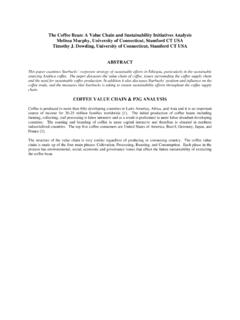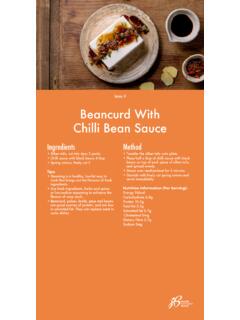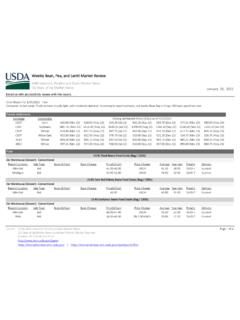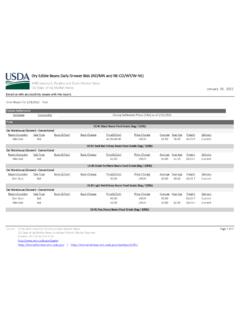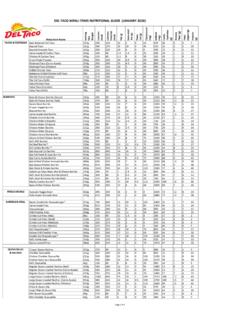Transcription of SUGAR BEAN GROWERS GUIDE - Seed Co Limited
1 SUGAR bean GROWERS GUIDE Contents Soils and climate.. 2 Varietal choice .. 2 Planting and crop establishment.. 2 Fertilisation.. 2 Plant spacing for beans sown on 45cm rows: .. 2 Plant spacing for beans sown on 50cm rows: .. 3 3 Pests.. 4 Harvesting.. 4 2 Soils and climate. Beans may be grown on a wide range of soils, but they generally prefer soils with some clay content (> 15 %), and they are sensitive to soil acidity. Beans are best grown during the cooler months of summer (January to April) on the highveld or in winter in the lowveld with irrigation. In the Highveld, SUGAR bean can be grown after frost occurance. Varietal choice A number of varieties are available, from speckled SUGAR beans, for example SC Bounty and SC Sharp types to white broad beans. It is important to select the right variety for the intended market, as there are definite market preferences. The most preferred is the speckled type. Also, choose varieties that are resistant to Rust, Anthracnose, Angular Leaf Spot and Common Mosaic Virus diseases.
2 Beans are prone to diseases transmitted through the seed, so good quality, disease-free certified seed from Seed Co should be obtained. Do not keep seed from your own crop, but rather buy in good seed each year. Planting and crop establishment. This depends somewhat on the variety. Short determinate varieties ought to be planted in 45 cm rows with 5 to 10 cm between plants, giving a population of about 350,000 plants per ha. Tall indeterminate varieties may be planted on wider spacings. Seed is placed about 2 cm deep. Fertilisation. Beans are sensitive to acid soils, so lime is required if the pH is less than 5,3. Beans are efficient users of residual fertiliser but nevertheless they do respond to applied fertiliser, especially if the soil is inherently fertile. Beans may be fertilised with manure or low rates (200 to 350 kg per ha) of a compound fertiliser ( ). A light top dressing with 100 kg/ha with a 28-34% N fertiliser ( Ammonium Nitrate) just before flowering may also be required if the leaves are pale in colour.
3 Plant spacing for beans sown on 45cm rows: In-row Plant Type Spacing Population 3 (cm) (Plants/ha) Speckled (SC Sharp/Bounty) 10 222 000 Speckled (SC Sharp/Bounty) 8 278 000 Speckled (SC Sharp/Bounty) 6 370 000 Speckled (SC Sharp/Bounty) 4 556 000 Plant spacing for beans sown on 50cm rows: In-row Plant Type Spacing Population (cm) (Plants/ha) Speckled (SC Sharp/Bounty) 10 200 000 Speckled (SC Sharp/Bounty) 8 250 000 Speckled (SC Sharp/Bounty) 6 333 000 Speckled (SC Sharp/Bounty) 4 500 000 Diseases Rust is a common disease, which initially shows itself as small yellow-white lesions (spots) on the older leaves. These enlarge and become reddish-brown. Most of the older varieties are susceptible to rust, but usually the newer varieties have some resistance. Several fungicides are registered for control of rust 4 ( , Mancozeb and Triademnol Shavit). These may be applied either as a preventative spray or when the disease is first seen.
4 Generally, several sprays are required at intervals of 7 to 14 days. A number of other diseases are also common, such as Angular Leaf Spot (a fungus disease common on speckled beans), Anthracnose (fungus), Common Blight (bacteria), Halo Blight (bacteria), and bean Common Mosaic Virus. Some of the fungal diseases may be controlled with appropriate chemicals, but for the other diseases, clean seed, crop hygiene and crop rotation is important for control. Avoid walking through wet crops. Pests. The bean fly often causes serious problems in dry bean fields. The larva of the fly mines from the leaf down into the stem, causing the stem near the soil to swell and crack and eventually break. Crop rotation may limit the damage, while sequential planting of bean crops in adjacent fields should be avoided. Diazinon may provide some control if applied at 3, 6, 13 and 20 days after emergence. A number of other pests may attack beans, such as aphids, blister (CMR) beetles, chafer beetles, stink bugs, and boll worms.
5 Chemicals are available for the control of these. Harvesting. When the pods are almost dry, but before they shatter, cut plants and wind-row. Thresh when fully dry. If the grain is being kept for home consumption, treat appropriately to avoid infestation with bruchids and weevils. 5






